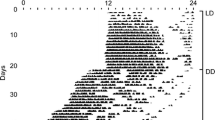Abstract.
Running wheels are widely used in studies on biological rhythms. In mice wheel diameters have ranged from 11 cm to 23 cm. We provided mice with running wheels of two different sizes: 15 cm diameter and 11 cm diameter. The amount of running in the 12-h light:12-h dark condition and the endogenous period of wheel running in constant darkness was determined over 40 days. On the 1st day in constant darkness all animals were exposed to a 15-min light pulse at circadian time 13. The animals in the small wheel ran significantly less both in 12 h light:12 h dark and constant darkness, and showed a longer endogenous period in constant darkness compared to animals in the large wheel. Moreover, after the light pulse at circadian time 13, mice in the small wheel showed a significantly smaller phase delay in running wheel activity than mice in the larger wheels. The data suggest that the magnitude of a photic phase shift depends on the amount and timing of activity the animals display in relation to this stimulus. It can be concluded that technical features of the running wheel can influence the circadian period of wheel running.
Similar content being viewed by others
Author information
Authors and Affiliations
Additional information
Electronic Publication
Rights and permissions
About this article
Cite this article
Deboer, T., Tobler, I. Running wheel size influences circadian rhythm period and its phase shift in mice. J Comp Physiol A 186, 969–973 (2000). https://doi.org/10.1007/s003590000150
Accepted:
Issue Date:
DOI: https://doi.org/10.1007/s003590000150




